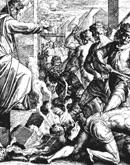The Riverside Art Museum
My “ex” was an art history major at Emory; my interest was primarily in architecture. During our many museum visits, her focus was on fine art, mine was on design and construction. While I’m still passionate about architecture, my current interest is art. That brings us to our docent. Years ago I would have relished his guessing game at the old YWCA: “what do you suppose this room was used for?” Yes, those fine hardwood floors were dribbled on by basketballs, not paint. And bad acoustics screams “indoor pool.”
Nevertheless, I enjoyed hearing about the building’s architect, Julia Morgan. Imagine, a woman designing our machismo Americanus, Hearst Castle. I don’t know what she learned at The Beaux-Arts Institute, but she must have been very in touch with her inner male.
Milford Zornes choreographs watercolors in ways I didn’t know possible. Best in show: Grand Canyon, 2005. Could he capture California light or what?
Gallery #2. I enjoyed most of the six artists, but I fell into the trap of thinking too much like an art historian… long on left brain, short on “guts.” Janet Rosener’s smooth surfaces and soft edges were reminiscent of Helen Frankenthaler (that’s a good thing, I love her work). Leestermaker’s bold colors with central black themes are worthy of my living room while Thibeaut’s abstracted “cityscape” amazed me; the impression of the Superdome appeared as a roofed city, perhaps Roman. But his Leroy Neiman style turned me off. Here is a quote from the movie Airplane, the scene where the bad guys are frustrated by the protagonist’s ability to resist traditional torture:
Do you want me to bring out the LeRoy Neiman paintings?
No. We cannot risk violating the Geneva Convention.
Finally, Werfel’s “all over” paintings were too busy for my taste; they go too far all over the place.
Sweeny Art Gallery
Pedro Alvarez undoubtedly digs deeply into the Cuban soul, but his political/social satire loses some of it poignancy on Americans. Of greater interest to me was Andrew Jackson (catalyzer of American Indian diaspora) juxtaposed against the noble dispossessed “savage” in the Romantic Dollarscape Series. The Disney series suggests a Dalian dream (surreal juxtaposition of melting “cheese” and cheesy American entertainment), within an uncanny de Chirico tableau (13.6), plus Eros (see the uncircumcised phallic candles on the right of Cecilia Valdes in Wonderland).
Incognegro: New Work by Mark Steven Greenfield. Enough already, we get it! But inventive, nevertheless, for an old symbolic warhorse of racial cliché. Yes, we are all racists, but most of us are working on it. And that’s good.
UCR/CMP Digital Studio Gallery
More people have had cameras inside of them (read “colonoscopy” or “arthroscopic surgery”) than have been inside a camera. Now I can proudly say I’ve been both inside a camera obscura and have had an obscure camera inside of me.
 I applaud the City of Palm Desert for moving toward an outdoor smoking ban (April 29). But secondhand smoke from cigarettes is dwarfed by the volume of exhaust emitted by parked vehicles. Don't believe me? Try parking your car in the garage with your engine running for say 30 seconds. If you live to tell about it, compare that amount of pollution with thirty seconds worth of second hand cigarette smoke.
I applaud the City of Palm Desert for moving toward an outdoor smoking ban (April 29). But secondhand smoke from cigarettes is dwarfed by the volume of exhaust emitted by parked vehicles. Don't believe me? Try parking your car in the garage with your engine running for say 30 seconds. If you live to tell about it, compare that amount of pollution with thirty seconds worth of second hand cigarette smoke.


























